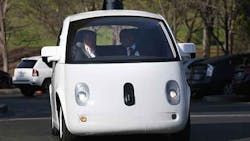Google Racks Up Its First Self-Driving Accident
An autonomous vehicle being tested by Google hit a bus earlier this month, the first time the company said its self-driving technology is partly to blame for an accident.
The car, a Lexus sports utility vehicle, hit the left side of a public transit bus as it was attempting to avoid some sand bags on a road in Mountain View, California. The automobile had a test driver, who saw the bus approaching in the mirror but "believed the bus would stop or slow to allow the Google AV to continue," according to an accident report filed with the state’s Department of Motor Vehicles.
Google is betting that its efforts will lead to a future when a large number of cars on the road will drive themselves, and has been testing autonomous vehicles on streets near its headquarters for the past few years. The company acknowledged that the technology still needs work. The incident with the bus happened because the car’s software also predicted the bus behind it would yield so it could merge back into traffic.
"We can imagine the bus driver assumed we were going to stay put," Google wrote in its February monthly report on self-driving cars, which Bloomberg obtained. "Unfortunately, all these assumptions led us to the same spot in the lane at the same time. This type of misunderstanding happens between human drivers on the road every day."
No injuries were reported, and the Google car’s left front fender, front wheel and a sensor were damaged. The car was traveling at 2 miles per hour (3.2 kph) and the bus was moving at 15 mph. Google has now made changes to its software so that its cars are less likely to believe buses and other large vehicles will yield for it, the company said.
While Google has taken partial responsibility for the collision, other incidents have typically involved the cars being rear-ended by human drivers, rather than the Google self-driving automobile driving into another vehicle.
About the Author
Bloomberg
Licensed content from Bloomberg, copyright 2016.
